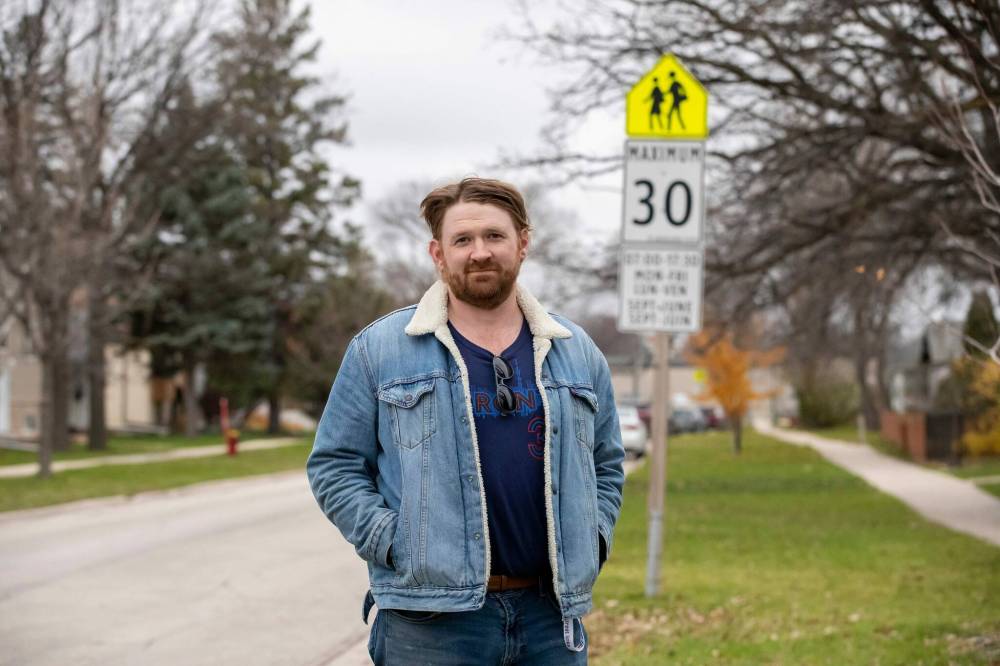Education
Trustees Demand Redesign of School Zones for Safer Streets

Trustees in Winnipeg are urging the City Council to rethink the design of 30 km/h school zones to enhance safety for all community members, including students, residents, and workers. They are also seeking a role in shaping this infrastructure overhaul to better protect their wards.
Ryan Palmquist, a trustee representing Ward 3 and an avid cyclist, has been vocal about road safety, motivated by personal experiences as a parent. His son’s daily journey to École Varennes underscores the importance of this issue. Palmquist’s commitment stems from a tragic incident on February 13, 2018, when an eight-year-old boy, Surafiel Musse Tesfamariam, was struck and killed at a nearby crosswalk. The death led to key upgrades at the intersection, yet no charges were filed against the driver.
Palmquist, who campaigned for his position in 2022 following this tragedy, promised to advocate for safer streets and enhanced community programs. His efforts have gained traction; recently, the Louis Riel School Division board unanimously supported his motion to collaborate with metro boards to ensure regular consultations on traffic safety around schools.
The Manitoba School Boards Association is convening trustees in Region 5 to prioritize initiatives for the 2025-26 period. If Palmquist’s proposal is recognized as a priority, it could advance to the association’s annual general meeting in 2026, potentially leading to broader discussions regarding school zone safety.
In a related development, Coun. Vivian Santos has proposed the implementation of year-round, 24-hour reduced speed limits in school zones, responding to concerns that current regulations do not adequately address safety outside of designated hours. In a letter dated October 9, Santos emphasized that school properties are utilized extensively beyond the traditional school day, with children and families frequenting these areas for various activities.
A recent investigative series has highlighted that the existing 30 km/h speed limit has not effectively curbed traffic violations. Winnipeg features approximately 150 school zones with reduced speed limits in effect from September 1 to June 30, typically from 7 a.m. to 5:30 p.m. on weekdays. Last year, nearly 32,000 photo radar violations were recorded, primarily in high-traffic areas.
Research from a team at the University of Winnipeg indicates that certain streets, such as Talbot Avenue, are chronic hotspots for speeding violations. This specific area generated over 5,000 speeding tickets last year alone. Despite the significant revenue these violations produce for the city, there has been little political momentum to enhance signage or implement infrastructure improvements aimed at reducing speeding.
Alan Campbell, president of the Manitoba School Boards Association, pointed out that most schools experience congestion during drop-off and pick-up times. He noted that while many schools lack adequate drop-off zones, these issues are symptomatic of broader challenges related to urban planning and traffic management.
Palmquist believes that trustees are vital stakeholders in road safety discussions, yet their perspectives are often marginalized. He criticized the current photo radar system, describing it as predatory and advocating for a redesign that could more effectively deter speeding. “Predatory speed traps could easily be redesigned or re-engineered to eliminate speeding,” he stated, stressing the interconnectedness of these issues.
Both Palmquist and Ian Walker, a fellow trustee and member of the Safe Speeds Winnipeg initiative, have called for a comprehensive study of traffic violations to inform future adjustments to road safety measures. Sandy Nemeth, board chair, expressed optimism that the motion will receive support from other boards, emphasizing that traffic violations impact entire school communities.
Since the beginning of the school year, there have been at least three incidents involving students within the Louis Riel division, highlighting the urgent need for enhanced safety measures. As discussions continue, the focus remains on ensuring that all students can navigate their routes to school without the risk of harm.
For further updates on this developing story, please follow our coverage on local education and safety initiatives.
-

 Lifestyle2 months ago
Lifestyle2 months agoWinnipeg Celebrates Culinary Creativity During Le Burger Week 2025
-

 Health3 months ago
Health3 months agoMontreal’s Groupe Marcelle Leads Canadian Cosmetic Industry Growth
-

 Science3 months ago
Science3 months agoMicrosoft Confirms U.S. Law Overrules Canadian Data Sovereignty
-

 Education2 months ago
Education2 months agoBrandon University’s Failed $5 Million Project Sparks Oversight Review
-

 Science3 months ago
Science3 months agoTech Innovator Amandipp Singh Transforms Hiring for Disabled
-

 Education2 months ago
Education2 months agoRed River College Launches New Programs to Address Industry Needs
-

 Technology2 months ago
Technology2 months agoDragon Ball: Sparking! Zero Launching on Switch and Switch 2 This November
-

 Technology3 weeks ago
Technology3 weeks agoDiscord Faces Serious Security Breach Affecting Millions
-

 Technology3 months ago
Technology3 months agoGoogle Pixel 10 Pro Fold Specs Unveiled Ahead of Launch
-

 Science2 months ago
Science2 months agoChina’s Wukong Spacesuit Sets New Standard for AI in Space
-

 Education2 months ago
Education2 months agoAlberta Teachers’ Strike: Potential Impacts on Students and Families
-

 Technology3 months ago
Technology3 months agoWorld of Warcraft Players Buzz Over 19-Quest Bee Challenge
-

 Business2 months ago
Business2 months agoRocket Lab Reports Strong Q2 2025 Revenue Growth and Future Plans
-

 Technology4 weeks ago
Technology4 weeks agoHuawei MatePad 12X Redefines Tablet Experience for Professionals
-

 Business2 months ago
Business2 months agoDawson City Residents Rally Around Buy Canadian Movement
-

 Business3 months ago
Business3 months agoNew Estimates Reveal ChatGPT-5 Energy Use Could Soar
-

 Technology3 months ago
Technology3 months agoFuture Entertainment Launches DDoD with Gameplay Trailer Showcase
-

 Science3 months ago
Science3 months agoXi Labs Innovates with New AI Operating System Set for 2025 Launch
-

 Technology3 months ago
Technology3 months agoInnovative 140W GaN Travel Adapter Combines Power and Convenience
-

 Business2 months ago
Business2 months agoBNA Brewing to Open New Bowling Alley in Downtown Penticton
-

 Technology3 months ago
Technology3 months agoGlobal Launch of Ragnarok M: Classic Set for September 3, 2025
-

 Technology3 months ago
Technology3 months agoNew IDR01 Smart Ring Offers Advanced Sports Tracking for $169
-

 Education2 months ago
Education2 months agoNew SĆIȺNEW̱ SṮEȽIṮḴEȽ Elementary Opens in Langford for 2025/2026 Year
-

 Technology2 months ago
Technology2 months agoArsanesia Unveils Smith’s Chronicles with Steam Page and Trailer










